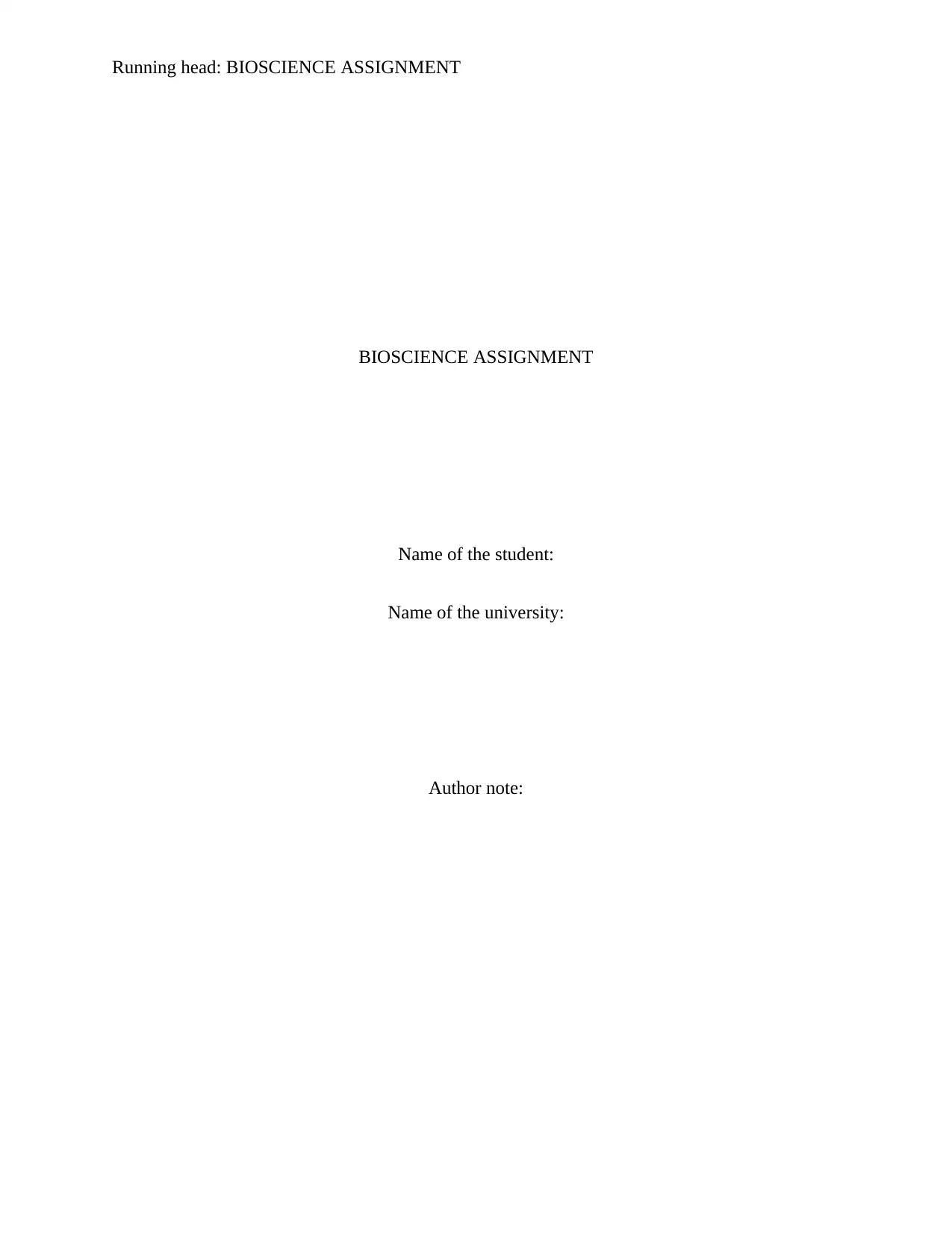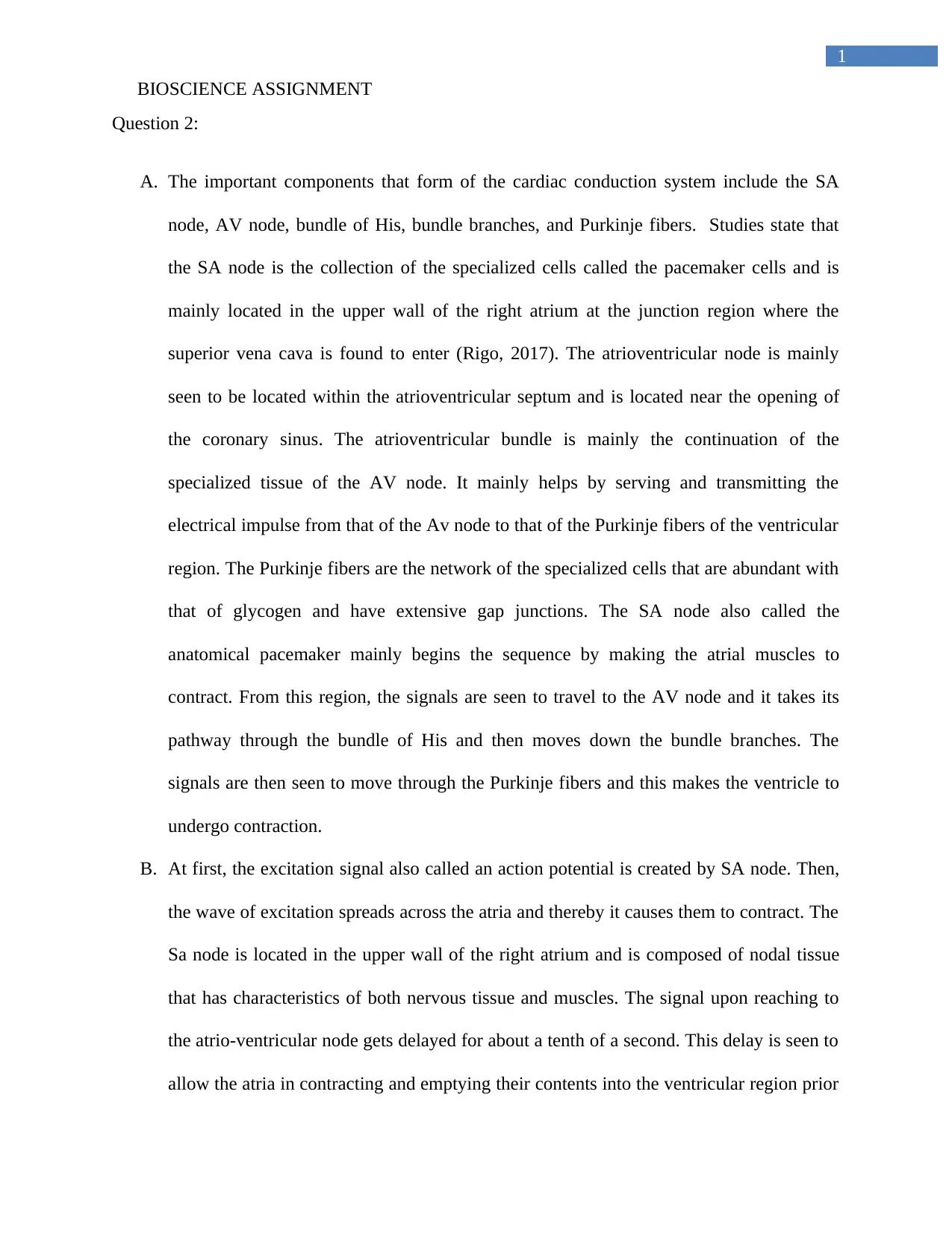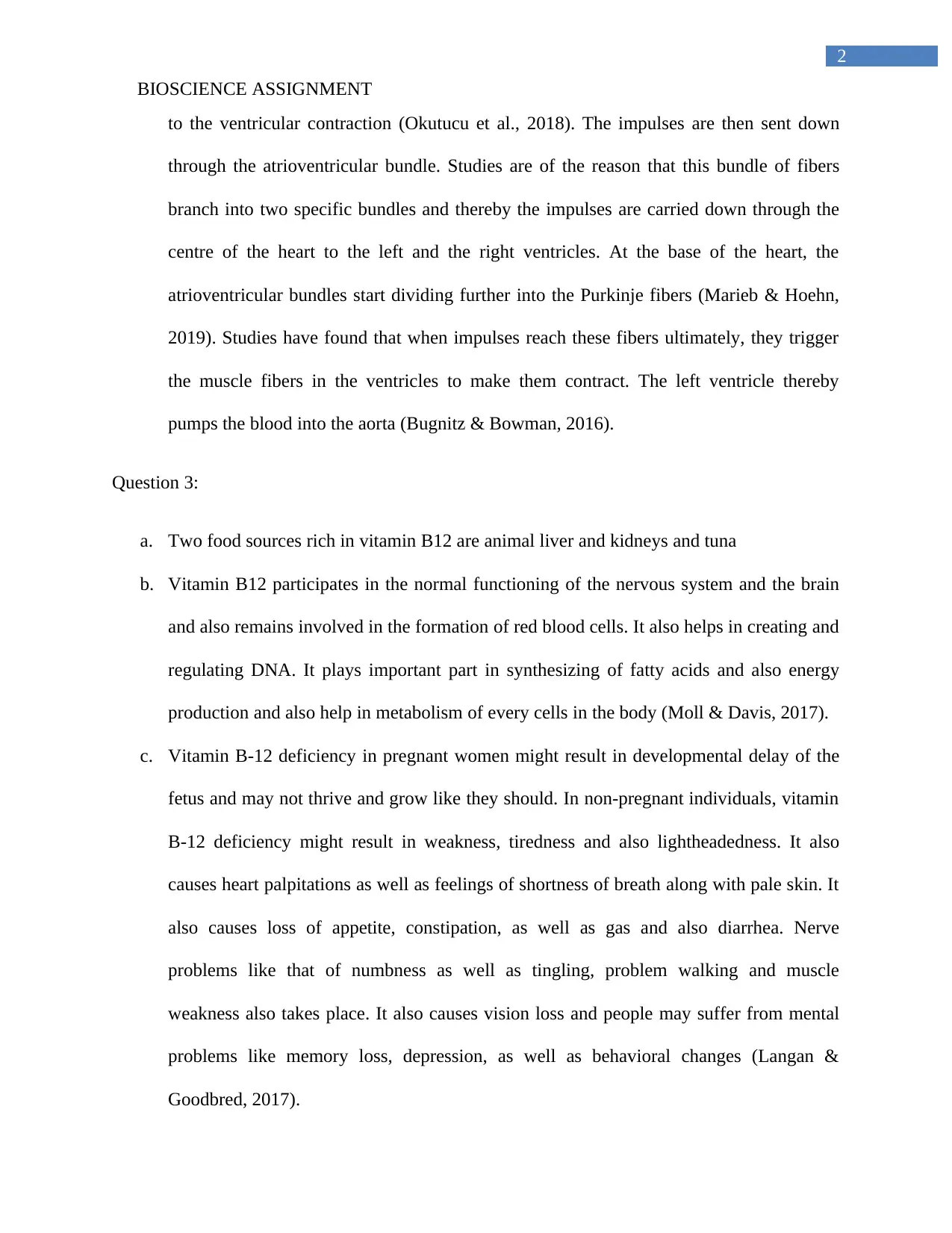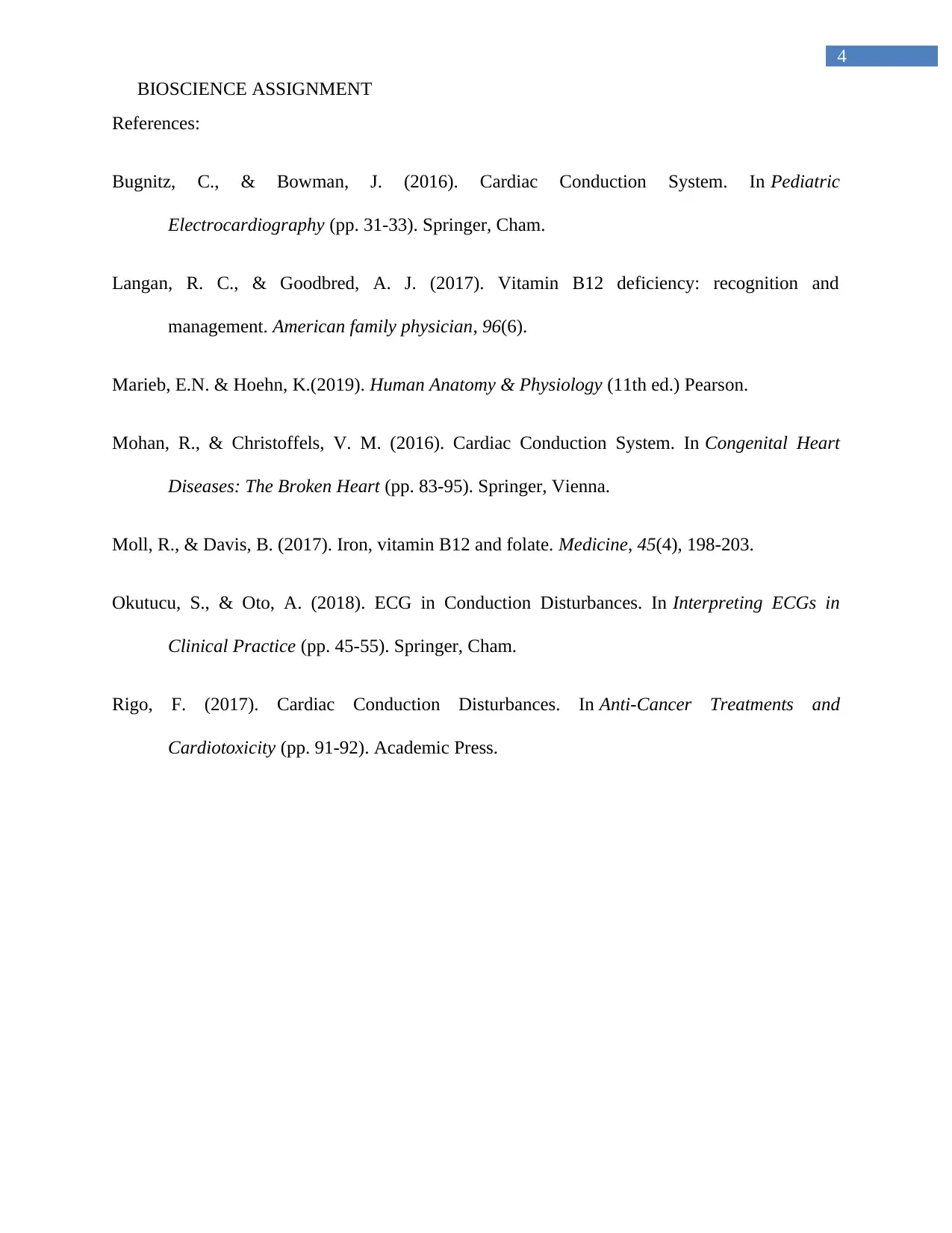Bioscience Assignment - University Biology Assessment 2 Part B
VerifiedAdded on 2022/12/22
|5
|998
|47
Homework Assignment
AI Summary
This bioscience assignment explores the cardiac conduction system, detailing its components such as the SA node, AV node, bundle of His, bundle branches, and Purkinje fibers. It explains the process of cardiac excitation and contraction, including the role of each component. The assignment also addresses vitamin B12, including its sources, functions in the body (nervous system, red blood cell formation, and DNA regulation), and the consequences of deficiency, such as developmental delays, fatigue, and nerve problems. It further discusses pernicious anemia, a condition where individuals cannot absorb vitamin B12 due to a lack of intrinsic factor. The assignment is well-referenced, demonstrating an understanding of bioscience concepts.

Running head: BIOSCIENCE ASSIGNMENT
BIOSCIENCE ASSIGNMENT
Name of the student:
Name of the university:
Author note:
BIOSCIENCE ASSIGNMENT
Name of the student:
Name of the university:
Author note:
Paraphrase This Document
Need a fresh take? Get an instant paraphrase of this document with our AI Paraphraser

1
BIOSCIENCE ASSIGNMENT
Question 2:
A. The important components that form of the cardiac conduction system include the SA
node, AV node, bundle of His, bundle branches, and Purkinje fibers. Studies state that
the SA node is the collection of the specialized cells called the pacemaker cells and is
mainly located in the upper wall of the right atrium at the junction region where the
superior vena cava is found to enter (Rigo, 2017). The atrioventricular node is mainly
seen to be located within the atrioventricular septum and is located near the opening of
the coronary sinus. The atrioventricular bundle is mainly the continuation of the
specialized tissue of the AV node. It mainly helps by serving and transmitting the
electrical impulse from that of the Av node to that of the Purkinje fibers of the ventricular
region. The Purkinje fibers are the network of the specialized cells that are abundant with
that of glycogen and have extensive gap junctions. The SA node also called the
anatomical pacemaker mainly begins the sequence by making the atrial muscles to
contract. From this region, the signals are seen to travel to the AV node and it takes its
pathway through the bundle of His and then moves down the bundle branches. The
signals are then seen to move through the Purkinje fibers and this makes the ventricle to
undergo contraction.
B. At first, the excitation signal also called an action potential is created by SA node. Then,
the wave of excitation spreads across the atria and thereby it causes them to contract. The
Sa node is located in the upper wall of the right atrium and is composed of nodal tissue
that has characteristics of both nervous tissue and muscles. The signal upon reaching to
the atrio-ventricular node gets delayed for about a tenth of a second. This delay is seen to
allow the atria in contracting and emptying their contents into the ventricular region prior
BIOSCIENCE ASSIGNMENT
Question 2:
A. The important components that form of the cardiac conduction system include the SA
node, AV node, bundle of His, bundle branches, and Purkinje fibers. Studies state that
the SA node is the collection of the specialized cells called the pacemaker cells and is
mainly located in the upper wall of the right atrium at the junction region where the
superior vena cava is found to enter (Rigo, 2017). The atrioventricular node is mainly
seen to be located within the atrioventricular septum and is located near the opening of
the coronary sinus. The atrioventricular bundle is mainly the continuation of the
specialized tissue of the AV node. It mainly helps by serving and transmitting the
electrical impulse from that of the Av node to that of the Purkinje fibers of the ventricular
region. The Purkinje fibers are the network of the specialized cells that are abundant with
that of glycogen and have extensive gap junctions. The SA node also called the
anatomical pacemaker mainly begins the sequence by making the atrial muscles to
contract. From this region, the signals are seen to travel to the AV node and it takes its
pathway through the bundle of His and then moves down the bundle branches. The
signals are then seen to move through the Purkinje fibers and this makes the ventricle to
undergo contraction.
B. At first, the excitation signal also called an action potential is created by SA node. Then,
the wave of excitation spreads across the atria and thereby it causes them to contract. The
Sa node is located in the upper wall of the right atrium and is composed of nodal tissue
that has characteristics of both nervous tissue and muscles. The signal upon reaching to
the atrio-ventricular node gets delayed for about a tenth of a second. This delay is seen to
allow the atria in contracting and emptying their contents into the ventricular region prior

2
BIOSCIENCE ASSIGNMENT
to the ventricular contraction (Okutucu et al., 2018). The impulses are then sent down
through the atrioventricular bundle. Studies are of the reason that this bundle of fibers
branch into two specific bundles and thereby the impulses are carried down through the
centre of the heart to the left and the right ventricles. At the base of the heart, the
atrioventricular bundles start dividing further into the Purkinje fibers (Marieb & Hoehn,
2019). Studies have found that when impulses reach these fibers ultimately, they trigger
the muscle fibers in the ventricles to make them contract. The left ventricle thereby
pumps the blood into the aorta (Bugnitz & Bowman, 2016).
Question 3:
a. Two food sources rich in vitamin B12 are animal liver and kidneys and tuna
b. Vitamin B12 participates in the normal functioning of the nervous system and the brain
and also remains involved in the formation of red blood cells. It also helps in creating and
regulating DNA. It plays important part in synthesizing of fatty acids and also energy
production and also help in metabolism of every cells in the body (Moll & Davis, 2017).
c. Vitamin B-12 deficiency in pregnant women might result in developmental delay of the
fetus and may not thrive and grow like they should. In non-pregnant individuals, vitamin
B-12 deficiency might result in weakness, tiredness and also lightheadedness. It also
causes heart palpitations as well as feelings of shortness of breath along with pale skin. It
also causes loss of appetite, constipation, as well as gas and also diarrhea. Nerve
problems like that of numbness as well as tingling, problem walking and muscle
weakness also takes place. It also causes vision loss and people may suffer from mental
problems like memory loss, depression, as well as behavioral changes (Langan &
Goodbred, 2017).
BIOSCIENCE ASSIGNMENT
to the ventricular contraction (Okutucu et al., 2018). The impulses are then sent down
through the atrioventricular bundle. Studies are of the reason that this bundle of fibers
branch into two specific bundles and thereby the impulses are carried down through the
centre of the heart to the left and the right ventricles. At the base of the heart, the
atrioventricular bundles start dividing further into the Purkinje fibers (Marieb & Hoehn,
2019). Studies have found that when impulses reach these fibers ultimately, they trigger
the muscle fibers in the ventricles to make them contract. The left ventricle thereby
pumps the blood into the aorta (Bugnitz & Bowman, 2016).
Question 3:
a. Two food sources rich in vitamin B12 are animal liver and kidneys and tuna
b. Vitamin B12 participates in the normal functioning of the nervous system and the brain
and also remains involved in the formation of red blood cells. It also helps in creating and
regulating DNA. It plays important part in synthesizing of fatty acids and also energy
production and also help in metabolism of every cells in the body (Moll & Davis, 2017).
c. Vitamin B-12 deficiency in pregnant women might result in developmental delay of the
fetus and may not thrive and grow like they should. In non-pregnant individuals, vitamin
B-12 deficiency might result in weakness, tiredness and also lightheadedness. It also
causes heart palpitations as well as feelings of shortness of breath along with pale skin. It
also causes loss of appetite, constipation, as well as gas and also diarrhea. Nerve
problems like that of numbness as well as tingling, problem walking and muscle
weakness also takes place. It also causes vision loss and people may suffer from mental
problems like memory loss, depression, as well as behavioral changes (Langan &
Goodbred, 2017).
⊘ This is a preview!⊘
Do you want full access?
Subscribe today to unlock all pages.

Trusted by 1+ million students worldwide

3
BIOSCIENCE ASSIGNMENT
d. People who suffer from pernicious anemia are the group of people who cannot absorb
vitamin B12 from different types of food. It can be so because they are seen to lack
intrinsic (in-TRIN-sik) factor. This is a protein which is developed in the stomach.
Studies opine that a lack of this protein can lead to the deficiency of this vitamin.
BIOSCIENCE ASSIGNMENT
d. People who suffer from pernicious anemia are the group of people who cannot absorb
vitamin B12 from different types of food. It can be so because they are seen to lack
intrinsic (in-TRIN-sik) factor. This is a protein which is developed in the stomach.
Studies opine that a lack of this protein can lead to the deficiency of this vitamin.
Paraphrase This Document
Need a fresh take? Get an instant paraphrase of this document with our AI Paraphraser

4
BIOSCIENCE ASSIGNMENT
References:
Bugnitz, C., & Bowman, J. (2016). Cardiac Conduction System. In Pediatric
Electrocardiography (pp. 31-33). Springer, Cham.
Langan, R. C., & Goodbred, A. J. (2017). Vitamin B12 deficiency: recognition and
management. American family physician, 96(6).
Marieb, E.N. & Hoehn, K.(2019). Human Anatomy & Physiology (11th ed.) Pearson.
Mohan, R., & Christoffels, V. M. (2016). Cardiac Conduction System. In Congenital Heart
Diseases: The Broken Heart (pp. 83-95). Springer, Vienna.
Moll, R., & Davis, B. (2017). Iron, vitamin B12 and folate. Medicine, 45(4), 198-203.
Okutucu, S., & Oto, A. (2018). ECG in Conduction Disturbances. In Interpreting ECGs in
Clinical Practice (pp. 45-55). Springer, Cham.
Rigo, F. (2017). Cardiac Conduction Disturbances. In Anti-Cancer Treatments and
Cardiotoxicity (pp. 91-92). Academic Press.
BIOSCIENCE ASSIGNMENT
References:
Bugnitz, C., & Bowman, J. (2016). Cardiac Conduction System. In Pediatric
Electrocardiography (pp. 31-33). Springer, Cham.
Langan, R. C., & Goodbred, A. J. (2017). Vitamin B12 deficiency: recognition and
management. American family physician, 96(6).
Marieb, E.N. & Hoehn, K.(2019). Human Anatomy & Physiology (11th ed.) Pearson.
Mohan, R., & Christoffels, V. M. (2016). Cardiac Conduction System. In Congenital Heart
Diseases: The Broken Heart (pp. 83-95). Springer, Vienna.
Moll, R., & Davis, B. (2017). Iron, vitamin B12 and folate. Medicine, 45(4), 198-203.
Okutucu, S., & Oto, A. (2018). ECG in Conduction Disturbances. In Interpreting ECGs in
Clinical Practice (pp. 45-55). Springer, Cham.
Rigo, F. (2017). Cardiac Conduction Disturbances. In Anti-Cancer Treatments and
Cardiotoxicity (pp. 91-92). Academic Press.
1 out of 5
Related Documents
Your All-in-One AI-Powered Toolkit for Academic Success.
+13062052269
info@desklib.com
Available 24*7 on WhatsApp / Email
![[object Object]](/_next/static/media/star-bottom.7253800d.svg)
Unlock your academic potential
Copyright © 2020–2025 A2Z Services. All Rights Reserved. Developed and managed by ZUCOL.





